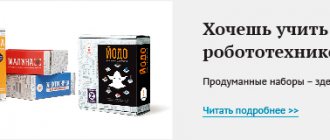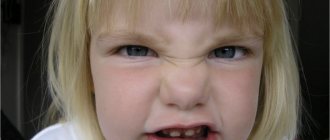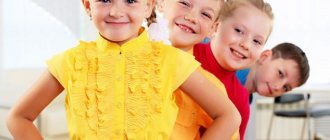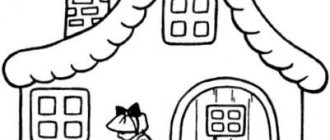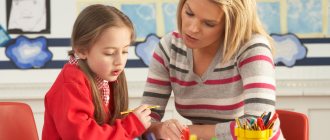Development of thinking in preschool children. How a person will grow up, what character qualities he will have, how active his thought process will be - is laid down in childhood. The preschool period is especially important. At this time, the body is undergoing intensive development, physical and mental, and the foundation of the individual is being laid.
Features of the development of thinking in a preschool child
Development of thinking in preschool children. During the preschool period, different types of thinking arise, and one becomes the basis for the emergence of another. The peculiarities of thinking depend on the acquired experience and knowledge that the child acquires on the path of growing up.
Thus, the prerequisites for thinking and understanding are laid from the very first months of life. The first rattle in a child’s life, the first actions with objects surrounding the baby - everything matters in establishing connections between a person and an object. Random actions can generate interest and attempts to repeat these actions again. For example, after hearing a rattle make sounds, your baby will shake it again to repeat the process.
In a small child, thinking cannot be conscious; it simply occurs as a consequence of the perception of reality. And only when the child begins to walk, gains motor activity, and thinking also actively develops. This stage begins when the child turns two years old. Moreover, initially thinking becomes a consequence of practical action. Without conscious brain function. Intelligence begins to develop when a child gets the opportunity to create something through games and educational, cognitive activities. As the child gains more and more knowledge, he learns to perform mental operations, and by the age of five he can analyze, compare, and generalize.
Article:
Preschool childhood is a period of intellectual development of all mental processes that provide the child with the opportunity to become familiar with the surrounding reality.
The child learns to perceive, think, speak; he masters many ways of acting with objects, learns certain rules and begins to control himself. All this presupposes the functioning of memory. The role of memory in the development of a child is enormous. Assimilation of knowledge about the world around us and about ourselves, the acquisition of skills and habits - all this is connected with the work of memory. Schooling places particularly great demands on a child’s memory.
To successfully master the school curriculum, a child needs not only to know a lot, but also to think consistently and convincingly, guess, show mental effort, and think logically.
Teaching the development of logical thinking is of no small importance for the future student and is very relevant today.
Mastering any method of memorization, the child learns to identify a goal and carry out certain work with the material to realize it. He begins to understand the need to repeat, compare, generalize, and group material for the purpose of memorization.
Teaching children classification contributes to the successful mastery of a more complex method of memorization - semantic grouping, which children encounter at school.
Using the opportunities for developing logical thinking and memory in preschoolers, we can more successfully prepare children to solve the problems that schooling poses to us.
The development of logical thinking includes the use of didactic games, ingenuity, puzzles, solving various logic games and labyrinths and is of great interest to children. In this activity, children develop important personality traits: independence, resourcefulness, intelligence, perseverance, and constructive skills. Children learn to plan their actions, think about them, guess in search of a result, while showing creativity.
Lessons on the development of elementary logical thinking for preschoolers are compiled using didactic games. After all, for them the game is the leading activity. Games of logical content help to cultivate cognitive interest in children, promote research and creative search, the desire and ability to learn. Didactic games are one of the most natural activities for children and contribute to the formation and development of intellectual and creative manifestations, self-expression and independence.
The development of logical thinking in children through didactic games is important for the success of subsequent schooling, for the correct formation of the student’s personality and in further education will help to successfully master the basics of mathematics and computer science.
In classes for the development of logical thinking, children play games rich in logical content, logical structures are modeled in them, and during the game they solve problems that help accelerate the formation and development of the simplest logical structures of thinking in preschoolers. These classes will help children in their future education to successfully master the basics of mathematics and computer science.
Various games are used in classes to develop logical thinking. Games such as “Who flies?”, “Edible - inedible”, “Riddles” - they help develop the child’s attention and intellectual abilities, and teach him to identify the essential features of objects.
Games where you need to look for the same properties or signs of objects: “Wonderful bag”, “Identify the object by touch”, “Find an object that distinguishes it from others”. In such games, the child learns to reason and be attentive.
Games and exercises teach you to be observant and attentive: “What is drawn?”, “Name the object in the row”, “Name the object in one word”, “What is extra? Why?”, “Dominoes”, “How can you name objects in one word.”
To develop intellectual abilities, children play a game such as “I know five...”. She teaches to classify and generalize.
The game “White Sheet” is aimed at developing the perception of the properties of objects, such as shape, size, and developing hand motor skills.
Such exercises as “Fish-birds-animals”, “Clothes-furniture-dishes”, “Vegetables-fruits-berries”, as a result, children learn that representatives of a species are included within the genus.
To form the concepts of quantitative and qualitative concepts, we use the following exercises: “Find a picture with the shortest tree”, “Find a picture with the tallest boy”, “Show a medium-sized ball” and others.
The games “Mazes”, “Continue the Row”, “Place the Missing Piece” develop logical thinking, ingenuity, and ingenuity.
By the end of the preparatory group year, children play more complex games: “Computer”. “Knight's move”, “Games with hoops”, “Where, whose house?”. The purpose of these games is to form ideas about the algorithm, classification according to one property, and the formation of a logical operation.
So, in conclusion, we can conclude that the development of logical thinking, the ability to classify, generalize, group objects, build graphic models, the development of intellectual and personal qualities, self-expression and independence is important for successful mental development and subsequent schooling.
Didactic games, various conversations, puzzles, labyrinths, riddles contribute to the development of the ability to find similarities and differences in objects, highlight the most significant features, group objects based on common features, and ensure that children learn general names.
Teaching children classification contributes to the successful mastery of a more complex method of memorization - semantic grouping, which children encounter at school.
The development of the ability to think in preschoolers leads to certain changes in the behavior and psyche of children: self-control and independence of their activities increases.
When teaching children through play, there is a desire for the joy of play to gradually turn into the joy of learning. Learning should be joyful.
Lesson on the elementary development of logical concepts in the preparatory group
Goal: To teach children to select species concepts for generic ones and vice versa.
Continue to teach children to independently build a model of relationships between concepts. To consolidate the idea of a system of graphical display of classification of concepts. Continue to work on your reasoning skills; develop attention, thinking, observation. To foster in children a sense of teamwork, to be attentive to each other, and to help their comrades in difficulties.
Material:
- Demonstration: models of planets, moon, stars, hung on the ceiling; rocket, attributes for playing in space; flashlight, labyrinths, logic tree models, Euler circles, “Find 10 differences” illustration, chalk, pointer.
- Handout: subject pictures, models of geometric figures, models with a symbol of a person, geometric figures; cut illustrations.
Hod: Guys, look how many guests we have today. Let's say hello.
– And now, the brave crew of the starship “Curious Thinkers”, line up for the space flight. (The teacher is the supposed flight commander, he has a cap on his head. The flight commander gives the command. The children put on attributes).
Captain (one of the children): The crew of “Curious Thinkers” is ready for space flight. Allow me to go.
Flight Director: I give you permission to go on space travel. Bon Voyage!
Captain: The crew should take their places. (The children get into the rocket, which is built from large building material.) 5,4,3,2,1 – start. (The lights turn off, space music from the group “Space” plays.)
The captain finds planets with a flashlight and comments:
- Attention, to the left of the side is the giant planet Jupiter. It is the second brightest planet after Venus. Jupiter is orange.
- Attention, to the left of the side is the brightest and most beautiful planet Venus. She is named after the goddess of love.
- Attention, the next planet is Mars. Radio operator say hello to the Martians.
- Attention, I see the planet Saturn. Admire the splendor of his rings. Through a telescope, it is noticeable that Saturn’s ball is greatly flattened.
- Attention, the Moon is in front of us. Lunar craters are visible on the Moon.
A loud knock is heard, the flashlight runs from side to side.
Captain: The rocket collided with an unknown object, the pressure dropped. There was an emergency landing. (The lights turn on, the children get up from their seats)
Children: - Where are we? Where are we? What do we do?
(Pleasant music is heard. A teacher appears in a star costume)
Star: Don't worry guys, I am a magical star and will help you on your journey. I will help you find out where you are and return home. But are you not afraid of difficulties? (No). Then let's go. Using the lunar map we will find a way out. (The teacher shows a colored sheet with a broken red line).
Captain: The team should split into two groups to make it easier to examine the left and right sides.
Tests
I. On the board are diagrams of the logical tree. Assignment for the first group of children.
- Guys, we need to decipher the models. This big dot will be the animals that live in the forest, but what will these small dots be called?
(With the help of a pointer, children name the points: fox, hare, wolf, squirrel, bear, hedgehog)
Assignment for the second group of children:
- And now I will name the small dots, and you will name the large dot.
(Pig, cow, sheep, dog, cat, calf are domestic animals)
Teams receive pebbles for correct answers.
Star: According to the lunar map, we need to pass the next test, and it is located in this area.
II. For each child, there are sets of subject pictures on the tables. You need to determine what is unnecessary and why.
Children receive pebbles for correct answers.
Star: And now our path lies in this direction. But again we need to overcome an obstacle. Can you handle him? (Yes). Then go ahead.
III. On the floor are sets of models for constructing a logical tree. The first team builds a model of “geometric shapes”. The second team is the “Man” model.
Star: Well done, all the teams coped with such a difficult obstacle and received pebbles. Now, according to the lunar map, we have to go through labyrinths. Let's send scouts to explore the area and help us get out. (Teams choose one child each - a scout).
IV. Scout competition.
Labyrinths are drawn on two Whatman papers. The scouts complete the task “Quickly go through the maze.”
For successfully completing this task, children receive pebbles.
Star: According to the lunar map, now we need to turn here. (Children approach the tables on which there are sets of geometric shapes)
V. The first team makes the figure of a hare from geometric shapes.
The second team makes a parsley figure.
Star: guys, now you and I have to find ten differences in the picture.
(A picture is drawn on whatman paper, and each child names the difference, for which he receives a pebble)
VI. Game “Find ten differences”
Star: And now another test. You guys need to make a picture out of the parts.
VII. Game “Make a picture from parts”.
Star: Our journey ends. You did everything correctly, and therefore everything worked out for you. I am very glad that you are so smart and attentive. Now we need to count the pebbles and each team needs to find a star with the same number as the number of pebbles the team has. You will be able to read the planet you were on.
(Children count pebbles and find stars with the name “Logic”)
Children: The country is called Logic.
Star: Well done, children. You have truly traveled through the amazing country of Logic. Only brave, smart guys can get here and emerge victorious. And you have proven that you are exactly like that. For this I will help you return to kindergarten. I will give you these starships. (Zvezda gives paper starships to the children)
Star: Goodbye, good journey. (The children seem to fly away, playing out the plot with starships.)
Lesson on the elementary development of logical concepts in the preparatory group
Topic: Competition for savvy people “Hurry up and don’t make a mistake”
Goal: To learn to process information, draw conclusions: generalize objects according to a certain criterion, isolate an extra object. Strengthen ordinal counting and the ability to work with geometric shapes with children. Develop imaginative thinking, memory, speech. Cultivate perseverance, ingenuity and ingenuity.
Material:
- Demonstration: posters - labyrinths, illustration “Find 10 differences”, tambourine, chips, riddles - jokes. Prizes for children: paper boats and spaceships.
- Handout: subject pictures, models of geometric shapes, cards with a blank: rings of pyramids are drawn;
Hod: Guys, today we will have a competition of savvy and resourceful people. He will win it. whoever will not be distracted, solves everything quickly and correctly, and completes the task faster than others, I will give a chip. At the end of the competition, each of the children will count the chips, and we will find out who the winner is.
The teacher invites the children to choose chips of two colors, during which two teams are formed. Working at tables.
- Task: find a piece of paper where a pyramid is drawn: you need to paint over the first, third, fifth rings. Whoever does this quickly, beautifully and accurately gets a chip.
- Assignment: draw the desired shape into an empty cell and explain why. The teacher listens to the children’s answers and marks them with chips.
- Assignment: arrange the pictures in a row, look carefully and say what is superfluous here and why. The teacher listens to the children’s reasoning and marks the answers with chips.
- Game - warm-up: to the music or to a tambourine, children perform the following tasks: walk at a pace, jump one after another, run, jump around themselves, walk on their tiptoes, run scattered around the hall, march.
- Near the edge of the carpet there are envelopes with geometric shapes. Game “Vanka - Stand up”: whoever is the first to lay out any object from the figures that he has in the envelope must stand up to his full height. Children lay out objects, the teacher marks the children with chips.
- Game “Who can go through the maze the fastest?” According to the counting, one child is selected, the fastest one brings the team a chip.
- Task: find ten differences. First, one team names the differences, then the other.
- 8. Problems - jokes are made one by one. – There were 4 apples on the table, one was cut in half. How many apples are on the table? (four) - There were 3 glasses with berries on the table. Vova ate 1 glass of berries and put it on the table. How many glasses are there on the table? (three) - Grandmother was walking to the market, carrying a basket of eggs, and the bottom fell. How many eggs are left in the basket? (not one) - Three birds were sitting on the path, the cat crept up and ate one bird, how many birds were left? (none)
- Game “Numbers Get Lost”
- Game “Count by touch”
The results of the competition are summed up, the chips of the team as a whole are counted, and awards are given.
– Well done, guys, you turned out to be the most savvy, the most dexterous, erudite, and attentive. Such qualities are needed by those who work as pilots, fly into space, they will receive prizes - spaceships. And I will give ships to the other team, you will be captains.
Lesson on the elementary development of logical concepts in the senior group
Topic: Selection of generic concepts to specific ones.
Goal: Continue to teach children to establish and graphically display relationships between concepts, and to use concept symbols. Continue to strengthen the ability to classify concepts on different grounds; develop logical thinking, imagination, memory and observation.. Foster in children a sense of teamwork, the ability to empathize with each other, and the desire to help a friend in difficulty.
Material:
- Demonstration: a set of illustrations of animals: wild animals, birds, fish, insects; pictures for the game “Logic Train”, toys, ball.
- Handout: sets of subject pictures, cards with geometric shapes, geometric shapes; sheets of paper, pencils.
Progress: Guys, close your eyes and listen. What do you hear? (Buzz). Who could be buzzing? (Beetle, bee, fly). You named it correctly, but it was the cheerful Carlson who came to visit you. Why is he buzzing? That's right, it has a motor.
- Hello guys! I really love to play. Let's play.
Offers the game “Say it in one word”, uses a ball to play the game.
- Guys, I wanted to look at the pictures, but they fell and got mixed up. Help me figure it out.
– Shall we help Carlson? (Yes)
Working with Euler circles. Children divide the pictures into two groups: flowers and animals. Animals are divided into four groups: animals, birds, insects, fish.
– Now let’s sketch out all the divided groups so that Carlson can understand it more clearly. (The teacher draws on the board, children on pieces of paper).
– Carlson thanks the guys and offers to play some more.
Game “What's extra”.
- Carlson is such a naughty person, he deliberately put in an extra card and wants to see how observant you are. (Carlson checks how the children completed the task.)
– And Carlson is such an entertainer, he loves to play. He says that he is the greatest inventor and dreamer. Take a card with a geometric figure and find an envelope with the same figure. (Children throughout the group are looking for their envelopes).
“Then they fantasize themselves and lay out shapes from geometric shapes, and Carlson guesses.
Carlson asks a riddle:
The brothers got ready to visit, clung to each other, and rushed off on a long journey, only leaving a smoke behind.
- That's right, guys, it's a train. And Carlson suggests playing the game “Logic Train”: children take cards in order and put them in trailers, but you must explain why you are placing this trailer. It will be delivered correctly if you correctly explain what features the pictures have in common.
The game “Logic Train” is played.
The lesson is summed up, Carlson thanks the children for how they played and gives them “Riddle” candies.
- Guys, Carlson liked playing with you, you are so great. He brought you a gift with a surprise: you will eat the candy, and we will collect the candy wrappers, and then we will guess the riddles that are written on them.
Lesson on the elementary development of logical concepts in the preparatory group
Topic: Selection of generic concepts to specific ones.
Goal: To teach children to select generic concepts for specific ones and vice versa.
Continue to teach children to independently build a model of relationships between concepts. Introduce children to the system of graphically displaying the classification of concepts in the form of “Euler Circles”. Introduce the possibility of comparing the volumes of concepts; development of thinking and attention. Develop the ability to work in a team.
Material:
- Demonstration: cards with images of utensils (tea, coffee, kitchen), pointer, chalk, Euler circles.
- Handout: pencils and paper..
Progress:
I. Children stand in a circle, the teacher with the ball is in the center of the circle.
- The teacher invites the children to listen to several names and give a common name for everything listed. The child to whom the teacher throws the ball answers. (For example: cup, spoon, saucer, plate - dishes; spinning top, ball, doll - toys; etc.)
- The teacher gives a general name, and the children list the concepts related to it. (Flowers - rose, chamomile, tulip; etc.)
II . There is a circle with the image of a “mouse” on the table. Children match the generic concept to the specific one. Another circle with the image of an “apron”. Children choose clothes for this concept. The third circle with the image of a saucepan. Dishes are selected for this concept. This circle is divided into three small circles and sorted into three types: kitchen utensils, coffee utensils, and tableware. Children compare concepts of the same level of generality and generic and specific concepts.
III.
- A didactic game is being held: “What is unnecessary here? Why?". Children give answers.
- Logical problem: consider Toropyzhka and Wick. What is the difference between Toropyzhka and Wick? How are they similar? How will the houses of Toropyzhka and Fitilya differ?
Children look at the illustration and give answers.
At the end of the lesson they summarize their work. The teacher says that for active work the children receive a gift from Toropyzhka and Fitil. How to find out who gave which candy? (Toropyzhka is a long and narrow candy. And Wick is small and thick).
Types of thinking: stages of child development
Development of thinking in preschool children. The following types of thinking dominate in a preschooler:
- objective-active, which develops spurred by the child’s imagination; typical for children aged 1 to 2 years.
- visual-figurative, which develops on the basis of the child’s existing knowledge; typical for children aged 3 to 4 years.
- verbal-logical, since speech begins to play an important role in achieving any goal of the child; typical for children of older preschool age - 5-7 years.
Subject-effective thinking
The youngest preschoolers love to break toys. They are not aggressors releasing negative energy, they are explorers. The objects that surround the child are interesting to him, he wants to touch them and take them apart. One action follows another. Speech is not important here, and the little ones do not yet have the ability to speak and explain their actions. The child thinks with his hands, exploring the properties of each object.
Visual-figurative type of thinking
When a child turns three or four years old, he already owns certain images that he actively uses in play. At the same time, objective-active thinking occurs; visual-figurative thinking simply becomes its continuation.
Verbal and logical thinking
At the age of five, preschoolers are already actively chatting, can analyze information, and give a detailed answer. They use speech in play and in everyday life; children remember that with the help of speech it is easier to achieve the desired result.
Abstract-symbolic
With this thinking, the child can separate the essential properties, signs of an object from the unimportant. The baby understands that a specific object can be replaced by another if it has the same characteristic features.
Creative thinking (creativity)
Creativity knows no boundaries or age differences. Whether at two or six years old, a child can enthusiastically build castles with blocks, knead plasticine, or move a brush with paint over a sheet of paper. At the same time, the child makes or draws what he wants, showing imagination. The child also sings, plays music, and dances with his soul.
Mental operations
Observing how a child’s thinking develops, the entire thought process can be divided into stages:
- comparison;
- analysis;
- synthesis;
- generalization.
At the comparison stage, the child learns to find the same in different things, different in the same. During this period, it is appropriate to give “find the differences” pictures and play memory games (start with 6 pairs of pictures, gradually increasing the number).
At the analysis stage, features, qualities, properties, materials and objects used are identified. In his imagination, a child can divide any product into its component parts.
The synthesis stage is closely related to the analysis stage. Without analysis it will not be possible to synthesize. An example of this is reading. Without remembering letters, without understanding how they merge into syllables, a child will not be able to read.
Vivid signs of generalization are the identification of common characteristics of objects and grouping. As soon as a child develops coherent speech and the use of a large number of generalizing concepts, you know that the generalization stage has begun.
Exercises and games to develop thinking in preschool children
In order for thinking to actively develop, you need to constantly work with your child. To help parents and educators there will be didactic, educational and entertainment classes, excursions, meetings with specialists, as well as regular games with children.
Development of imaginative thinking in a preschooler
To develop imaginative thinking, games that involve “gray cells” are suitable. For example, an adult invites a child to look at a picture that shows various objects, but they can all be called in one word. These can be dishes, various animals, items of clothing, furniture, and transport.
Another good option is puzzles. To assemble a picture from many elements, you need to present it as a whole, pay attention to individual details, look for common features in the illustration in order to obtain the integrity of the image.
You can offer to play the game “Everything on the shelves”. In this game, from a bunch of completely different objects, you need to find only those that correspond to specific characteristics.
Development of logical thinking in preschool children
Both oral games and the use of visual materials will help to develop logical thinking.
Good oral games such as:
- "Let's make up a fairy tale"
In this game, the adult starts the story, and the child’s task is to finish it.
- "Yes and no"
A game with leading questions to which the second player answers: “Yes” or “No.” The task is to eventually guess the item conceived by the first player.
- "Association"
In this exercise you are asked to select words by association: Dress - summer, fur coat... (winter);
squirrel - hollow, bear... (den), etc.
Using visual materials:
- Make shapes from counting sticks.
- Play the “labyrinth” in the picture, helping the character along the path.
- Use the illustrations to create a story.
Development of creative thinking
Creative thinking is impossible without the child’s imagination and ability to operate with images. You can offer your child the following games and exercises:
- find familiar images in the blot,
- create an object from several different parts,
- find the same signs in different pictures,
- guess what an object is based on an oral description.
- draw using unconventional drawing.
Development of spatial thinking
In order for a child to navigate the world around him, he needs to develop spatial skills. Games suitable for this:
- with matches, when you need to build new ones from created figures,
- with drawings, when the child is invited, for example, to play a pirate and find a treasure, following the plan,
- exercise “Farther - Closer”, when the child is asked to move objects to close and far distances at the request of a parent or teacher,
- With your eyes closed, following the teacher’s instructions, you need to draw a line on a piece of paper.
Basic forms of thinking of preschoolers
The famous researcher of child intelligence, Jean Piaget, defined the entire preschool age as a stage of specific operations. However, this stage does not end with the child entering school, but continues until the age of 11.
While living through this stage, children first gain the ability to build mental representations of objects and phenomena through actions. Then they discover the ability to imagine images and act with them internally. And almost on the threshold of school, they discover the ability to think logically.
Accordingly, from an early age until entering school, one can observe how the types of thinking in preschoolers consistently develop with the dominance of the most characteristic of their age:
- Visually effective
- Visual-figurative
- Verbal-logical
Each subsequent form of thinking does not displace the previous one. At each age level, the child thinks both in the way he is accustomed to and adds new approaches.
Visual-effective thinking
Once again, we emphasize that the development of a child’s thinking is triggered by action. “I do - I observe what I do - I begin to understand something” - this is how the mechanism of the simplest thought processes works. Therefore, it is called visual-effective thinking.
The baby’s mental attempts are tied to visual situations and reflect direct relationships between objects. For example, when scooping porridge with a spoon, almost every child intentionally or accidentally turns the spoon over so that the contents fall onto the table. This simple experiment allows him to understand how to use such cutlery.
The next discovery will be the shape of the spoon. It turns out that you can’t do without the concavity of this tool if you want to eat soup.
Thinking for a 3-4 year old child means performing certain actions and observing what is happening, and not remembering and reflecting.
Thus, gradually, visually effective thinking is formed as the discovery of subject connections - between the components and characteristics of one object, between different objects, etc. Thanks to the accumulated experience, the child’s type of thinking acquires important characteristics:
- abstraction
- generality
Distraction is manifested in the fact that the child identifies an important feature and begins to use objects variably. For example, a plastic disk has just served as the steering wheel of an imaginary car, and now a preschooler is using it as a plate from which he feeds a doll. In this case, the shape of the object tells the child how to use it.
Generalization of thinking lies in the use of the same object for different purposes. For example, a younger preschooler can put small toys in a bucket, and then shake everything out and try it on as a headdress or use it as a chair.
Visual-figurative form
Experience in practical actions is an indispensable step for the development of the next type - visually imaginative thinking.
Productive activities are especially useful for developing creative thinking. When intending to build, sculpt or draw something, a child at least vaguely imagines the result. This already contains an intellectual task: “I want to do it... But how can I implement it?”
What features should you focus on to draw an apple? Probably on its round shape. And to make it even more similar to the original, you should add a ponytail with a leaf.
The preschooler draws models of the objects he sees around him. And this is only possible if he notices important characteristics of objects, analyzes, establishes differences and similarities with other objects.
An important feature of visual figurative thinking is that a child can imagine a certain object and come up with its image using memories and using imagination.
This implies the main properties of the figurative form of thinking:
- mobility
- structural organization
Thanks to the mobility of thinking, a preschooler is able to supplement his ideas. It is enough to show the baby the long ears of the toy, and he will immediately recognize the hare. This property extends to the child’s recognition of any objects familiar to him by visible elements.
The structural organization of mental activity is clearly manifested in design. To build a model from structural parts, the child thinks about the relative position of the parts and determines the sequence of connections. Thinking, he looks for ways to create an image that would correspond to the plan.
Role-playing games effectively develop children's imaginative thinking. It is in such games that preschoolers try to create typical images, analyze and mentally imagine situations that truthfully reflect real life or correspond to fantastic plots.
Visual-effective and visual-figurative thinking are closely intertwined. The child is driven by cognitive activity. He experiments, and thanks to actions and images, he discovers relationships, signs, characteristics, features in the world around him. These types of thinking bring the preschooler closer to understanding objective logical laws.
